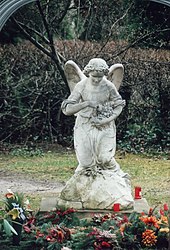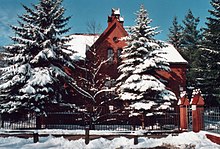Churchyard of St. Bartholomew
The St. Bartholomäus churchyard is the first and only church cemetery in Germany that houses a burial forest. It is located in the Berlin district of Weißensee and is the cemetery of the Protestant parish of St. Bartholomew . It has existed since 1894 and was laid out as an avenue district cemetery . The site extends over ten hectares . A good third of the area is forested and has been used for near-natural forest burials since 2013.
history
The parish of St. Bartholomäus was founded in 1854 as a subsidiary parish of St. Georgen and for a long time was able to bury its dead in the cemeteries of the mother parish. Because of the rapid population growth in Berlin, the community had been looking for its own area for burials since 1875, but it was not until 1892 that a 45- acre property on the Chaussee to Freienwalde was acquired in the then still independent rural community of Weissensee. The plant was opened in 1894 according to the plans of the government master builder Peters. The chapel was not ready for use until a year later, and the administration building followed in 1896.
In 1915 the first funerals of non-parishioners took place. In 1917 an honorary grove was laid out for those who fell in the First World War , and in 1966 a free-standing belfry was built to the northwest of the chapel.
In the years between 2003 and 2013 artistically designed fountains were built in various sections of the cemetery. In the urn grove, the artist Renate Wiedemann designed a fountain made of light Tittlingen granite . In 2010, she processed the column base of a historic Berlin facade made of old Silesian sandstone into a fountain with a bench in the park department. The stone sculptor Roland Luchmann continued the work with the facade parts with another fountain basin made from a column drum.
Since 2013 - initially in cooperation with the FriedWald company - forest burials have been offered. This made the Bartholomäus churchyard the first cemetery in an existing cemetery. Since November 2017, forest burials have taken place under the sole responsibility of the cemetery.
Cemetery complex
The entire complex, which has been a listed building since 1994, with its visual axes, the ensemble of chapel, portal and administration building, was preserved in its original state without any modifications.
The main axis of the symmetrically and orthogonally laid out cemetery actually begins with the avenue of linden trees in today's Giersstrasse, leading north from the portal to the chapel. Behind the chapel, this axis is extended today through a dense horse chestnut avenue to the circular grove of honor for the fallen of the First World War. The rectangular, three-axis clinker cladding building in neo-Romanesque style offers space for 85 visitors. After a comprehensive restoration with the installation of warm air heating, the altar area with its starry sky painting and the stained glass windows were restored in their original colors. Most of the furniture comes from the time it was built and is well preserved.
Ecological management
In 1994 old sewage pits were converted into rainwater cisterns and with 36 m³ are used for rain retention. The roof drainage of almost all buildings in the cemetery is connected here. Administration building, farm yard and waiting room are heated with their own wood.
The forest and green areas of the cemetery are managed sustainably and are a retreat for numerous animal species. In addition to deer, hawks, buzzards and raccoon dogs have settled here. The large wild meadows created at the edge of the forest in particular offer protection to insects, ground breeders and fawns. In the deciduous forest to the north there are at least 18 other tree species in addition to linden, chestnut, sycamore and sycamore: birch, yew, oak, ash, field maple, hornbeam, hawthorn, black pine, Serbian spruce, wood spruce, elm, bird cherry, Scots pine, walnut, hawthorn, White mulberry, white pine and plum. The conifers are more likely to be found in the southern part of the cemetery. An inventory of the woods and heisters has not yet been carried out.
Buried personalities
- Klaus Brasch (1950–1980), actor at DEFA and the Freie Volksbühne
- Peter Brasch (1955–2001), writer
- Hans-Georg Kammholz (1935–2000), merchant and undertaker
- Rainer Kerndl (1928–2018), writer and journalist
- Hans-Joachim Krusch (1935–2004), historian
- Michael Voges (1953–2002), painter and graphic artist
- Siegfried Weiß (1906–1989), member of the Berliner Ensemble and DEFA actor
- Klaus Zapf (1952–2014), moving company
Web links
- Website of the churchyard of St. Bartholomew
- Information sheet of the churchyard (PDF)
- Entry in the Berlin State Monument List
- Monument map Berlin
- Website of the sculptor Renate Wiedemann
- Website of the stone sculptor Roland Luchmann
literature
- Kerstin Lindstädt: Berlin Pankow. From the local and building history. , Mediapolis, Berlin 2010, ISBN 978-3932946004
- Heinrich Trost: The architectural and art monuments in the GDR: Capital Berlin II , Henschel 1987, ISBN 3-362-00138-6
Individual evidence
- ↑ Urns under poplars . In: Berliner Zeitung , November 1, 2013
- ↑ There is peace under all the tops . In: Der Tagesspiegel , November 24, 2013
- ↑ Anett Kirchner: Nature longing in the big city life. In: Friedhofskultur , May 2014
- ↑ Andreas Morgenroth: Valuation of cemetery overhang areas. Examples of subsequent uses , Königswinter 2009
- ↑ Andreas Morgenroth: The energy transition in the cemetery. Generation and use of regenerative energies on cemetery open spaces , Königswinter 2012
- ↑ How a socialist bon vivant lost a house and the Markus Wolf family won a house . In: Berliner Zeitung , October 17, 1996
- ↑ In the shadow of the wolf . In: Focus , May 26, 1997






